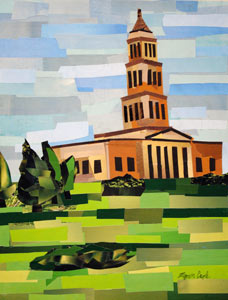
What can collage do that other mediums can’t?
When you paint a picture, every brushstroke of acrylic, oil, or watercolor paint you put down is more or less permanent. It sticks to the page or canvas, and you’re stuck with that mark until you can paint over it.
Collage is much more flexible than paint. It involves a lot of layering, and even if you use paint with your collage, you can always peel or cut back previous layers. It’s almost like an “undo” button on your computer. You can easily “undo” previous layers or sections.

How flexible a collage is depends on the materials you use. Megan Coyle makes collages out of magazine strips with a pair of scissors and glue stick. Using an acid-free glue stick lets her peel back previous layers pretty easily. She can also pull up different sections and move them around if need be. The type of glue you use can determine this flexibility. If you use a strong glue, it will be more difficult to peel off other layers. A glue stick is a pretty temporary type of glue – it’s not very permanent and doesn’t strongly adhere to objects like superglue or craft glue would.
Since glue sticks are not very strong, Coyle waits until she’s finished with a collage before she adheres the magazine strips with something more permanent. She takes a UV-protective varnish and paints a couple of coats on top of the artwork. This helps hold the pieces in place and also protects the work from the sun’s UV-rays, which can damage paper.

There are numerous ways to make a collage, which is why the medium is so interesting to work with. Some collagists gather various materials that they find discarded on the side of roads or walkways and assemble them to make mixed media art. There are all kinds of interesting found materials that can be used like discarded paper, cardboard, fragments of metal, and string. Other collagists work with natural materials like dried leaves while others collect elegant and patterned paper or fabric from art supply stores. Some even make and dye their own paper.
Megan Coyle enjoys recycling an ordinary object like a magazine and turning it into a work of art that looks a lot more like a painting than a paper collage. By manipulating the paper just so, she can make the paper resemble the brushstrokes in a painting. Take a look at her work.
Just imagine what other materials you could use to make original artwork – the possibilities are endless!

